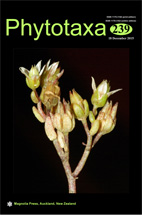Abstract
The fossil species Oreodaphne obtusifolia Berry (1916: 301) was described, based on the fossil leaf remains of the most abundant laurel from the Early Eocene Wilcox Group sediments of Holly Springs: Marshall Co, Grenada Co., Miss.: Mississippi embayment (Southeastern North America). Nowadays, most systematists consider the extant Oreodaphne to be a member of Ocotea (Mez, 1889: 219; Rohwer, 1986; van der Werff, 2002; Chanderbali et al., 2001). LaMotte (1952) transferred Berry’s (1916: 301) combination to Ocotea, and this transfer was followed by Dilcher (1963), who reinforced attribution of Wilcox leaf megafossils to Ocotea by cuticular analysis of epidermis and stomata (Dilcher & Lott, 2005). However, according to Art. 53.1 of the ICN (McNeill et al. 2012) the name Ocotea obtusifolia (Berry) LaMotte (1952) is illegitimate because of the existence of the earlier overlooked homonym, Ocotea obtusifolia Kunth (1817: 165–166), an extant lauraceous species from Colombia (Muséum National d’Histoire Naturelle, holotype: http://plants.jstor.org/stable/10.5555/al.ap.specimen.P00128771). The homonymy between these fossil and extant American species of Ocotea was revealed during the description of the new fossil Early Oligocene species Ocotea rossica Vikulin from the south of the Middle-Russian upland (Vikulin, 2015: 326). Since Ocotea obtusifolia (Berry) LaMotte has been systematically recognized as a valid species in current use and it does not have any synonym, a nomen novum, O. dilcherii, is formally proposed here as a replaced name. Because a type specimen was not indicated among the validating illustrations of Berry (1916: pl. 80, fig. 1; pl. 83, fig. 2–5, and pl. 84, fig. 1 and 2), a lectotype must be designated here, from the specimens illustrated in the protologue (Berry, 1916: 301–302) amongst those perfect specimens with blunt leaf apex, which are very abundant in the clays at Puryear, Tenn. (Proposed lectotype: paleobotany collection # USNM 35867, Smithsonian National Museum of Natural History (USA), illustrated in Berry, 1916: 301, pl. 83, fig. 5.

